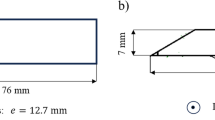Abstract
Rail steel samples have been tested for abrasive wear and sliding wear. It is shown that the wear resistance of rail steel is mainly determined by the carbon content therein and by the dispersity and structural homogeneity thereof: with increasing carbon content in the rail steel, the wear resistance exhibits an increase due to a decrease in the interlamellar distance of pearlite, as well as to a decrease in the amount of excess ferrite. Also, increasing chromium amount in steel promotes an increase in wear resistance. It has been found that the wear resistance of rail steel depends on the combination of hardness and plastic properties thereof. A high wear resistance level is predicted for rails made of hypereutectoid steel with a carbon content amounting to about 0.90% and a chromium content of about 0.30%



Similar content being viewed by others
REFERENCES
Chechel’nitskii, A.I. and Vaganova, A.N., Analysis of defectiveness and fracture of rails, in Uluchshenie kachestva i uslovii ekspluatatsii rel’sov i rel’sovykh skreplenii (Improving the Quality and Operating Conditions of Rails and Rail Fixers), Yekaterinburg: Ural. Inst. Met., 2020, pp. 66–75.
Bespalov, S.A., Destruction of metallic materials during friction, Usp. Fiz. Met., 2009, vol. 10, pp. 415–435.
Prohaska, S. and Jörg, A., Next-generation super-premium rail steels hit the tracks, Int. Railway J., 2015, vol. 52, no. 10, pp. 55–58.
Polevoi, E.V., Yunin, G.N., Yunusov, A.M., et al., Wear resistance of rails, Steel Transl., 2019, vol. 49, no. 7, pp. 492–495.
Gavrilyuk. V.G., Raspredelenie ugleroda v stali (Carbon Distribution in Steel), Kiev: Naukova Dumka, 1987.
Kurdyumov, G.V., The crystal structure of hardened steel, in Problemy metallovedeniya i fiziki metallov (Metal Science and Physics of Metals), Moscow: Metallurgiya, 1968, no. 9, pp. 8–23.
Schastlivtsev, V.M., Mirzaev, D.A., Yakovleva, I.L., et al., Perlit v uglerodistykh stalyakh (Perlite in Carbon Steels), Yekaterinburg: Ural. Otd., Ross. Akad. Nauk, 2006.
Gureev, D.M., Sidorov, A.P., and Yamshchikov, S.V., Wear of friction surfaces of 40KH steel before and after laser hardening, Trenie Iznos, 1992, vol. 13, no. 5, pp. 881–886.
Dakvort, V., Metalloved. Term. Obrab. Met., 1965, no. 11, p. 54.
Sorokin, G.M. and Malyshev, V.N., The nature of mechanical wear, Trenie Iznos, 2005, vol. 26, no. 6, pp. 598–607.
Sorokin, G.M. and Krivosheeva, Yu.V., Scientific principles for selection of wear resistant steels, Nadezhnost’ Sertifikatsiya Oborud. Nefti Gaza, 2003, vol. 31, no. 4, pp. 31–36.
ACKNOWLEDGMENTS
The sliding friction wear testing was carried out at Institute of Metal Physics of the Ural Branch of the RAS by Candidate Sci. (Engineering) V.A. Sirosh. The testing for abrasive wear resistance was performed at the Ural Federal University by Doctor Sci (Engineering), Professor M.A. Filippov. The authors express gratitude for their assistance in the studies.
Author information
Authors and Affiliations
Corresponding author
Additional information
Translated by O. Polyakov
About this article
Cite this article
Dobuzhskaya, A.B., Galitsyn, G.A., Yunin, G.N. et al. Effect of Chemical Composition, Microstructure and Mechanical Properties on the Wear Resistance of Rail Steel. Steel Transl. 50, 906–910 (2020). https://doi.org/10.3103/S0967091220120037
Received:
Published:
Issue Date:
DOI: https://doi.org/10.3103/S0967091220120037




